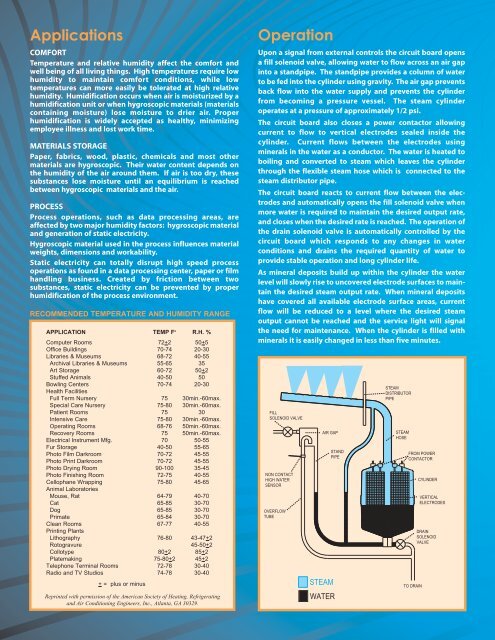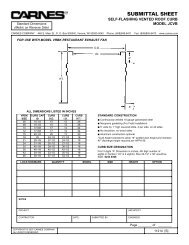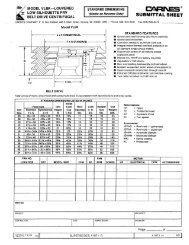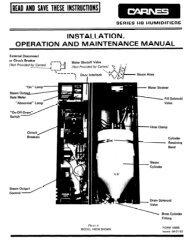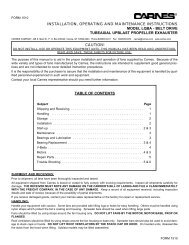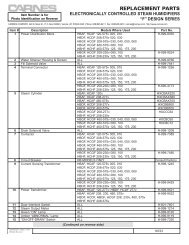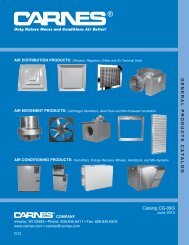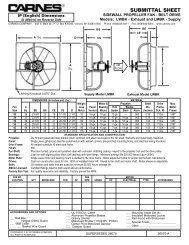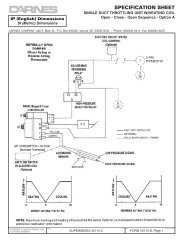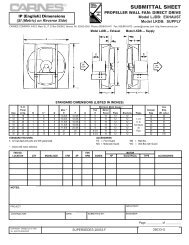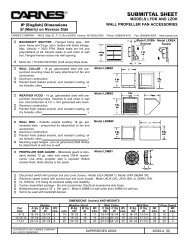Humidifier Brochure
Humidifier Brochure
Humidifier Brochure
You also want an ePaper? Increase the reach of your titles
YUMPU automatically turns print PDFs into web optimized ePapers that Google loves.
Applications<br />
COMFORT<br />
Temperature and relative humidity affect the comfort and<br />
well being of all living things. High temperatures require low<br />
humidity to maintain comfort conditions, while low<br />
temperatures can more easily be tolerated at high relative<br />
humidity. Humidification occurs when air is moisturized by a<br />
humidification unit or when hygroscopic materials (materials<br />
containing moisture) lose moisture to drier air. Proper<br />
humidification is widely accepted as healthy, minimizing<br />
employee illness and lost work time.<br />
MATERIALS STORAGE<br />
Paper, fabrics, wood, plastic, chemicals and most other<br />
materials are hygroscopic. Their water content depends on<br />
the humidity of the air around them. If air is too dry, these<br />
substances lose moisture until an equilibrium is reached<br />
between hygroscopic materials and the air.<br />
PROCESS<br />
Process operations, such as data processing areas, are<br />
affected by two major humidity factors: hygroscopic material<br />
and generation of static electricity.<br />
Hygroscopic material used in the process influences material<br />
weights, dimensions and workability.<br />
Static electricity can totally disrupt high speed process<br />
operations as found in a data processing center, paper or film<br />
handling business. Created by friction between two<br />
substances, static electricity can be prevented by proper<br />
humidification of the process environment.<br />
RECOMMENDED TEMPERATURE AND HUMIDITY RANGE<br />
APPLICATION TEMP F o R.H. %<br />
Computer Rooms 72+2 50+5<br />
Office Buildings 70-74 20-30<br />
Libraries & Museums 68-72 40-55<br />
Archival Libraries & Museums 55-65 35<br />
Art Storage 60-72 50+2<br />
Stuffed Animals 40-50 50<br />
Bowling Centers 70-74 20-30<br />
Health Facilities<br />
Full Term Nursery 75 30min.-60max.<br />
Special Care Nursery 75-80 30min.-60max.<br />
Patient Rooms 75 30<br />
Intensive Care 75-80 30min.-60max.<br />
Operating Rooms 68-76 50min.-60max.<br />
Recovery Rooms 75 50min.-60max.<br />
Electrical Instrument Mfg. 70 50-55<br />
Fur Storage 40-50 55-65<br />
Photo Film Darkroom 70-72 45-55<br />
Photo Print Darkroom 70-72 45-55<br />
Photo Drying Room 90-100 35-45<br />
Photo Finishing Room 72-75 40-55<br />
Cellophane Wrapping 75-80 45-65<br />
Animal Laboratories<br />
Mouse, Rat 64-79 40-70<br />
Cat 65-85 30-70<br />
Dog 65-85 30-70<br />
Primate 65-84 30-70<br />
Clean Rooms 67-77 40-55<br />
Printing Plants<br />
Lithography 76-80 43-47+2<br />
Rotogravure 45-50+2<br />
Collotype 80+2 85+2<br />
Platemaking 75-80+2 45+2<br />
Telephone Terminal Rooms 72-78 30-40<br />
Radio and TV Studios 74-78 30-40<br />
+ = plus or minus<br />
Reprinted with permission of the American Society of Heating, Refrigerating<br />
and Air Conditioning Engineers, Inc., Atlanta, GA 30329.<br />
Operation<br />
Upon a signal from external controls the circuit board opens<br />
a fill solenoid valve, allowing water to flow across an air gap<br />
into a standpipe. The standpipe provides a column of water<br />
to be fed into the cylinder using gravity. The air gap prevents<br />
back flow into the water supply and prevents the cylinder<br />
from becoming a pressure vessel. The steam cylinder<br />
operates at a pressure of approximately 1/2 psi.<br />
The circuit board also closes a power contactor allowing<br />
current to flow to vertical electrodes sealed inside the<br />
cylinder. Current flows between the electrodes using<br />
minerals in the water as a conductor. The water is heated to<br />
boiling and converted to steam which leaves the cylinder<br />
through the flexible steam hose which is connected to the<br />
steam distributor pipe.<br />
The circuit board reacts to current flow between the electrodes<br />
and automatically opens the fill solenoid valve when<br />
more water is required to maintain the desired output rate,<br />
and closes when the desired rate is reached. The operation of<br />
the drain solenoid valve is automatically controlled by the<br />
circuit board which responds to any changes in water<br />
conditions and drains the required quantity of water to<br />
provide stable operation and long cylinder life.<br />
As mineral deposits build up within the cylinder the water<br />
level will slowly rise to uncovered electrode surfaces to maintain<br />
the desired steam output rate. When mineral deposits<br />
have covered all available electrode surface areas, current<br />
flow will be reduced to a level where the desired steam<br />
output cannot be reached and the service light will signal<br />
the need for maintenance. When the cylinder is filled with<br />
minerals it is easily changed in less than five minutes.<br />
FILL<br />
SOLENOID VALVE<br />
NON CONTACT<br />
HIGH WATER<br />
SENSOR<br />
OVERFLOW<br />
TUBE<br />
AIR GAP<br />
STEAM<br />
WATER<br />
STAND<br />
PIPE<br />
STEAM<br />
DISTRIBUTOR<br />
PIPE<br />
STEAM<br />
HOSE<br />
FROM POWER<br />
CONTACTOR<br />
TO DRAIN<br />
CYLINDER<br />
VERTICAL<br />
ELECTRODES<br />
DRAIN<br />
SOLENOID<br />
VALVE


